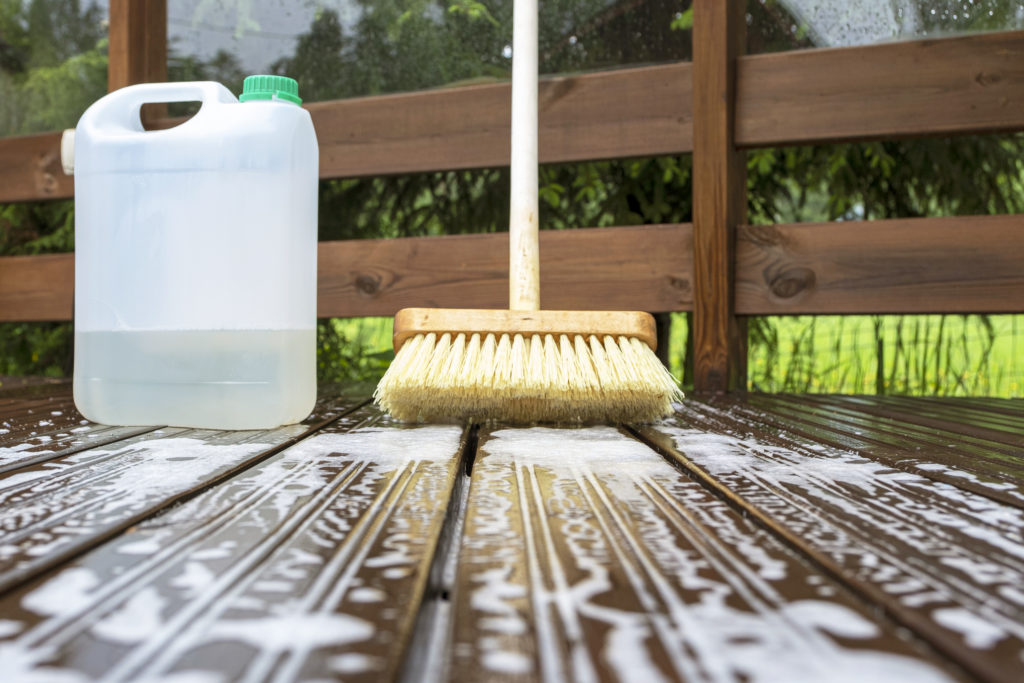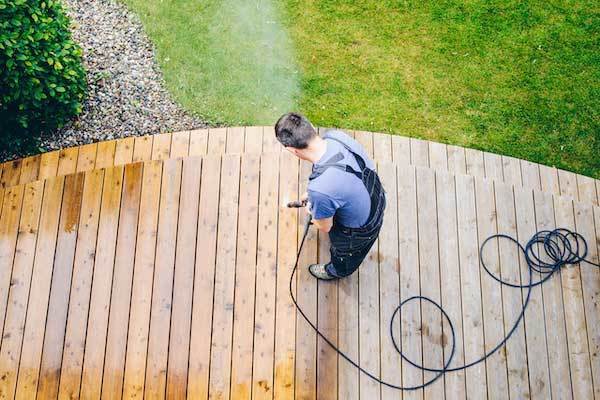The easiest mistake to make with deck pressure cleaning is applying too much pressure on the wood and damaging your boards.
While extremely effective at cleaning concrete, applying that much pressure to your deck will result in permanent damage. The fastest, most efficient way to clean your wood deck is using a high-pressure washer, but even scrubbing the pressure washer on your deck will damage it.
That is because the pressure washer absolutely cleans your deck, but it also destroys wood boards. It is also a terrible idea to use a power washer on a composite deck, because the power washer actually takes chips off of the composite material. For the most part, you can regularly clean a deck without using a power washer.
Wood and composite decks also sometimes clean well with power washing, but only when a professional does the job. This cleaning routine will make sure that your deck looks its best, and will keep you from reaching for your power washer often.
When it comes time to pressure wash your deck, there are some items that you will need to have in addition to just the pressure washer.
Power-washing, which is also often called scrubbing, is an excellent way to keep your deck looking its best, because it is usually the most efficient way to get the deck looking like new. With more and more of us worrying about our carbon footprint, global warming, and taking care of our environment, pressure washing is turning out to be less of an ideal option to cleaning your wood deck.

Between the cost, the unimpressive results, and the risk of damaging your deck, it is no surprise that more and more people are looking for safer, more efficient alternatives to pressure washing. In fact, it is better to not do any cleaning with a pressure washer than go overboard and ruin the deck with a solution that is too strong and can break down your deck finish.
While composite or synthetic wood can withstand a heavier pressure wash, the point is, a heavy pressure wash, particularly one over 1,500 pounds per square inch, will destroy your deck. To clean your deck efficiently, around 1,500 pounds of pressure is enough to get the job done well, and not do any lasting damage. Not all composites are created equal, but for the majority, you can pressure wash. All caps-type composites will tolerate light pressure washing. Do not go too heavy, as if you do, you are going toetch out the inner wood fibre core underneath the caps, leaving unsightly marks on the composite decking you cannot remove ever.
If you have mildewy mold on the top or your slushy concrete, just cover the surface with sand and apply a low-pressure. If there is mold or mildew present on your deck surfaces, clean your deck boards by hand with a paint brush — do not use a power washer to get rid of it.
Since pressure-cleaning will efficiently get rid of mold before it sets in your decks wood, it will also keep your boards from having to be replaced so frequently. Pressure-washing also increases the life of the wood stain on your deck, as well as protecting your wood from mold. Like natural wood decks, pressure treated wood decks will need annual cleaning to achieve optimal results.
Stone and rock, for instance, are more resistant to the effects of pressure than wooden surfaces, so there might be a few different options when it comes to the nozzles you use with your concrete or wood deck. Decks made from pressure-treated wood, like Southern Yellow Pine, generally hold up well under pressure, too, if you do not keep your spray nozzles too close together.
When you are pressure-cleaning a deck, it is important that you keep your nozzle moving, so you do not put the pressure on the same area for too long. When you are pressure cleaning a wood deck, you want to use a fan-like nozzle, which spreads water out evenly and gently, instead of a narrow tip, which applies heavy pressure on one tiny spot. You do not want to accidentally apply too much pressure on a surface that you are concerned with — such as the visible portion of your deck.
Too much pressure and you can leave an etching in your deck, too little and it results in a deck cleaner that is not as deep.
Leave soil and debris on the deck, and then applying water with high pressure will cause scratches or even chips. Use a soft broom to get rid of any surface mud from the deck before starting the pressure-cleaning.
This can be a good way to clean the deck deeply and remove embedded soil, but you do not want to get professional pressure washing on the deck too often (once per year is generally enough). You might think that you can just fire up a pressure washer and begin power washing immediately, but deck power washing is a risk. If you have a cedar deck, power washing is OK, but only at an extremely low pressure setting, not higher than 800 PSI.
Deck cleaning using a power washer using lower psi, typically about 1,200-1,500 psi, sometimes only as low as 800 psi, has begun replacing conventional pressure washing. When cleaning wood decks using soft wash, it is generally agreed that using a lower PSI, again around 1200-1500 PSI, with a fan at a 45-degree angle is best. Wood decks are particularly susceptible to being powered washed, as the pressure applied by a power washer may cause chipping.
The power washer is a labor- and time-saving tool, but if wielded with insecure hands, it can leave your deck looking as though bore-beetle larvae were at work. A pressure washer will sweep dirt and contaminants embedded in wood while also sprinkling on a deck stripper to strip away the prior finish.

